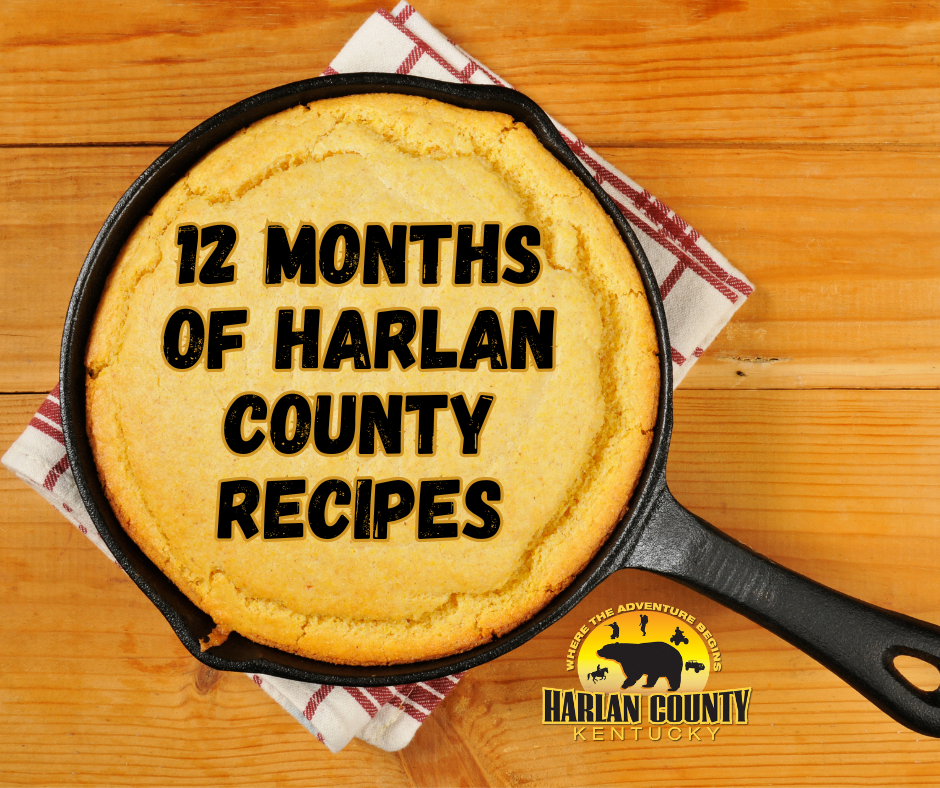As you’re making your New Year’s Resolution, consider making it a year of Harlan County Recipes with a special dish for each month.
January- Fried Cabbage Fried cabbage is a year round dish in the mountains but many locals will tell you it’s a must have on New Year’s Day. The recipe is simple. Melt butter in a skillet. Add chopped cabbage. Season with salt and pepper. You can elevate it with bacon or sausage or red pepper flakes but New Year’s cabbage has one important ingredient: a coin. Toss a cleaned coin into the cabbage for prosperity throughout the year.
February- Soup Beans & Cornbread The days are cold and you’ll need something satisfying and warm to get you through the snowy days. You’ll need to start ahead of time to soak your dry pinto beans for 8-12 hours. Drain them and then put them in water to cook on medium throughout the day. For extra flavor, add fat back to the pot. You can make some fancy changes like cooking in chicken stock or adding peppers and onions or just keep it simple like generations of Appalachians have. Serve it with cornbread, preferably cooked in a well seasoned cast iron skillet.
March- Chicken and Dumplings This dish is hearty enough for a later winter evening but also impressive enough to go on the church potluck table. Heat chicken stock in a pot while making your dumplings. Create a biscuit dough and either roll it out and cut it for flat dumplings or scoop balls of it into the stock for drop dumplings. If you’re looking for a quick alternative, cut canned biscuits into quarters and drop them in. Add chicken. Make sure it simmers with a lid on the pot so that all that heat stays in to help cook the dough thoroughly. To thicken the pot, add flour.
April- Ramps Everyone who enters your house will know by the strong smell that you’ve been cooking ramps but they won’t care because they’ll just be excited to share this Appalachian delicacy with you. This recipe begins with foraging and, as a reminder, always be careful when identifying plants in the wild for consumption. Every good Appalachian cook knows to save their bacon grease just for dishes like this. Cook the ramps on bacon grease and get ready to enjoy. Turn a side dish into a full meal by adding polish sausage to your ramps. Of course the easiest way to enjoy ramps is to come out to Evarts for the annual Ramp Festival every April!
May- Hickory Chickens You’ll hear them called hickory chickens or dry land fish but it’s important to know that they’re neither chicken nor fish. They’re mushrooms. Again, we want to remind you of the importance of correct identification when you go out in search of wild mushrooms! These favorites pop up in spring throughout the forests of Harlan County. While mountain people are generous, they probably won’t share their secret spot for finding hickory chickens! If you are fortunate to find your own, you can saute them in butter or slice them length wise and dip them in egg and seasoned flour before frying them in hot grease. No matter how you choose to prepare them, make sure they are well washed before cooking because the folds of the mushroom are great homes for tiny bugs.
June- Poke Sallet The unofficial start to summer begins when you see poke sallet poking up from the ground. Like always, be vigilant when foraging to make sure you’re picking poke sallet. Poke is poisonous so the preparation is VERY important. The leaves should be boiled and drained three times to remove toxins. To cook, saute it with bacon grease. Cut up a boiled egg in it for the full experience. This dish is so beloved that the first weekend in June is the Poke Sallet Festival in Downtown Harlan. While you enjoy the carnival, vendors, and live music, you can head to local restaurants for their take on Poke Sallet. Don’t miss Petunia the Possum, a two story mural on Central St. featuring a possum eating poke.
July- Berry Cobbler Make use of the abundance of fresh summer berries by picking blueberries and raspberries. Mix up a batter of 1 cup sugar, 1 cup flour, 1 cup milk, and a half stick of butter. Pour it in the pan and then top with blueberries and raspberries. Bake at 350 for 50 minutes. Once you top it with vanilla ice cream, you’ll have a red, white, and blue dessert perfect to enjoy before you head to town to watch fireworks!
August- Chow Chow August is a busy time of harvesting the last of the summer veggies and canning to put up food for the winter. Gather your cabbage, squash, onion, tomato, corn, bell peppers, cucumber, and pretty much anything from your garden. Chop, dice, and mix it all into a bowl. Sprinkle with pickling and canning salt. Toss everything around to coat it with the salt. Cover the bowl for at least 4 hours but, if you need a rest after all that cutting, cover the bowl and put it in the fridge overnight. Rinse the salt from the vegetables and add sugar, celery seed, dry mustard, mustard seed, turmeric, ginger, cinnamon, cloves, red pepper flakes, or whatever spices you prefer. Add in vinegar and let it simmer for 10 minutes before adding your veggies. Fill the jars and seal them well with a dip in a water bath. Use chow chow to top everything from a hot dog to soup beans!
September- The New Harlan Theater Style Chili September is the month when Harlan hosts the Dog Days of Kentucky hot dog festival. Celebrate by trying out one of Harlan’s most memorable chilis. The New Harlan Theater was a popular spot for live performances and movies in Downtown Harlan but it may have been most famous for its chili. The theater was situated on Main St. across from where The Harlan Center currently stands and crowds would line up to order chili even if they weren’t attending a show! We’re passing along a recipe for a trip down memory lane… Brown 2 lbs. of hamburger with 1 small onion, diced and then drain. Add 2 teaspoons of garlic salt, 1 1/2 tablespoons of chili powder, 1/4 teaspoon of salt, 1 tablespoon of A1 steak sauce, and tomato juice to taste. Simmer.
October- Apple Stack Cake The Apple Stack Cake is the crowning jewel of any Appalachian dessert spread. Bakers would brag about how thin their layers were and how many they could stack. The spiced cake gets its flavor from cinnamon, ginger, and allspice. The sorghum that sweetens the batter can often be picked up following sorghum stirring events in early fall. For vigilant bakers, the batter can be poured shallow into round pans and carefully timed to avoid overcooking. Some skip the worry of shot bake times and fry the batter like pancakes in a skillet or on a gridle. Well tested recipes may call for dried apples between each layer but, for a moister bite, use apple butter. Whether you make your own or purchase a jar, we recommend visiting the Apple Tree for apple products made from apples grown in Harlan County on the slopes of Kentucky’s tallest peak! If we can offer one tip, it would be to make and assemble the cake a few days before serving so all the delicious flavors blend together before serving.
November-Shuck Beans Preparing this holiday “must have” menu item actually begins in July or August. Ideally, work on beans during extremely hot weather with low humidity. Once you’ve removed the strings from fresh green beans, you can either break them and then dry them in the sun or string them whole onto lengths of thread that can be hung up to dry. The beans are not washed at this point and are put up just as they came from the garden. No matter the method you choose, the key is making sure the beans are completely dry with no moisture whatsoever. Many a heart has been broken when mold is found in the beans before Thanksgiving! Once the beans have dried, store them somewhere dry or bag them into plastic bags to protect them. Their appearance is brown and shriveled which inspires some to call them leather britches. To cook, soak the beans overnight to rehydrate them, changing water multiple times as dirt washes off. Put them in a pot with water and salt pork to simmer throughout the day. Leftovers are often enjoyed the following day on two pieces of white bread with an onion for a shuck bean sandwich.
December- Peanut Butter Roll As friends pass small tokens of love and appreciation during the Christmas season, it’s almost certain that you’ll be given peanut butter roll. This sweet treat begins with the combination of egg whites, sugar, water, corn syrup, and vanilla. The marshmallow like result should be carefully rolled out on parchment paper and then a generous helping of peanut butter spread across. Coat the parchment paper with powdered sugar so you can more easily lift the edge to begin to make your roll. The roll can be sliced with thread for presentation or left intact to be sliced later. If the process intimidates you, you can still enjoy peanut butter roll purchased from expert home bakers at annual events like the Festival of the Mountain Masters and Christmas at the Center!
Cook your way through an entire year of mountain favorites!


